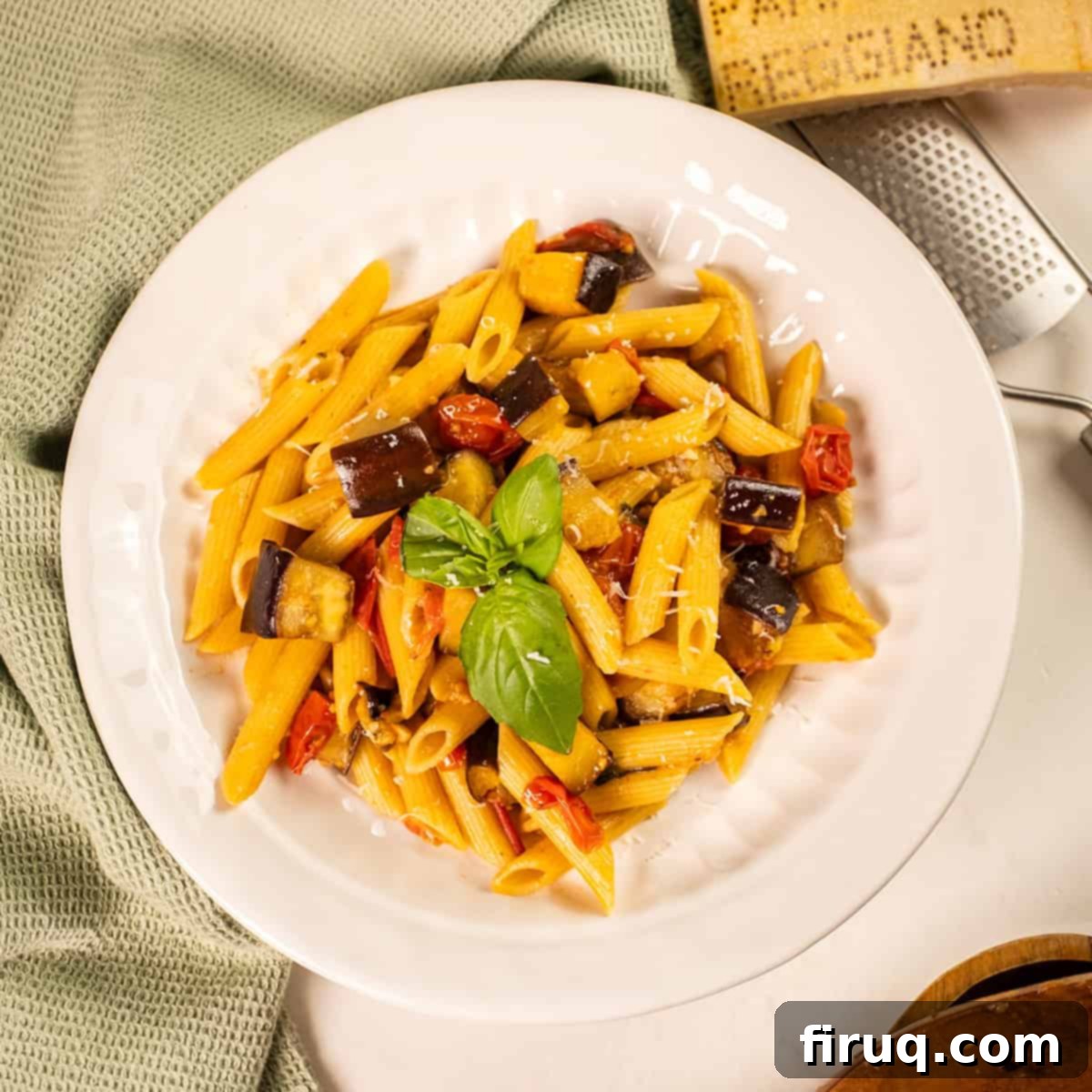Easy & Delicious Simple Pasta with Fried Eggplant and Cherry Tomatoes
Discover the ultimate weeknight wonder with this incredible Simple Pasta with Eggplant and Tomatoes! If you’re searching for a quick, satisfying, and flavorful meal, your quest ends here. This recipe is a delightful, easier take on the classic Pasta alla Norma, bursting with the vibrant taste of fresh cherry tomatoes and beautifully charred fried eggplant. It’s a perfect fusion of rustic Italian flavors and modern cooking simplicity, making it an ideal choice for a busy evening when you crave something wholesome and utterly delicious.
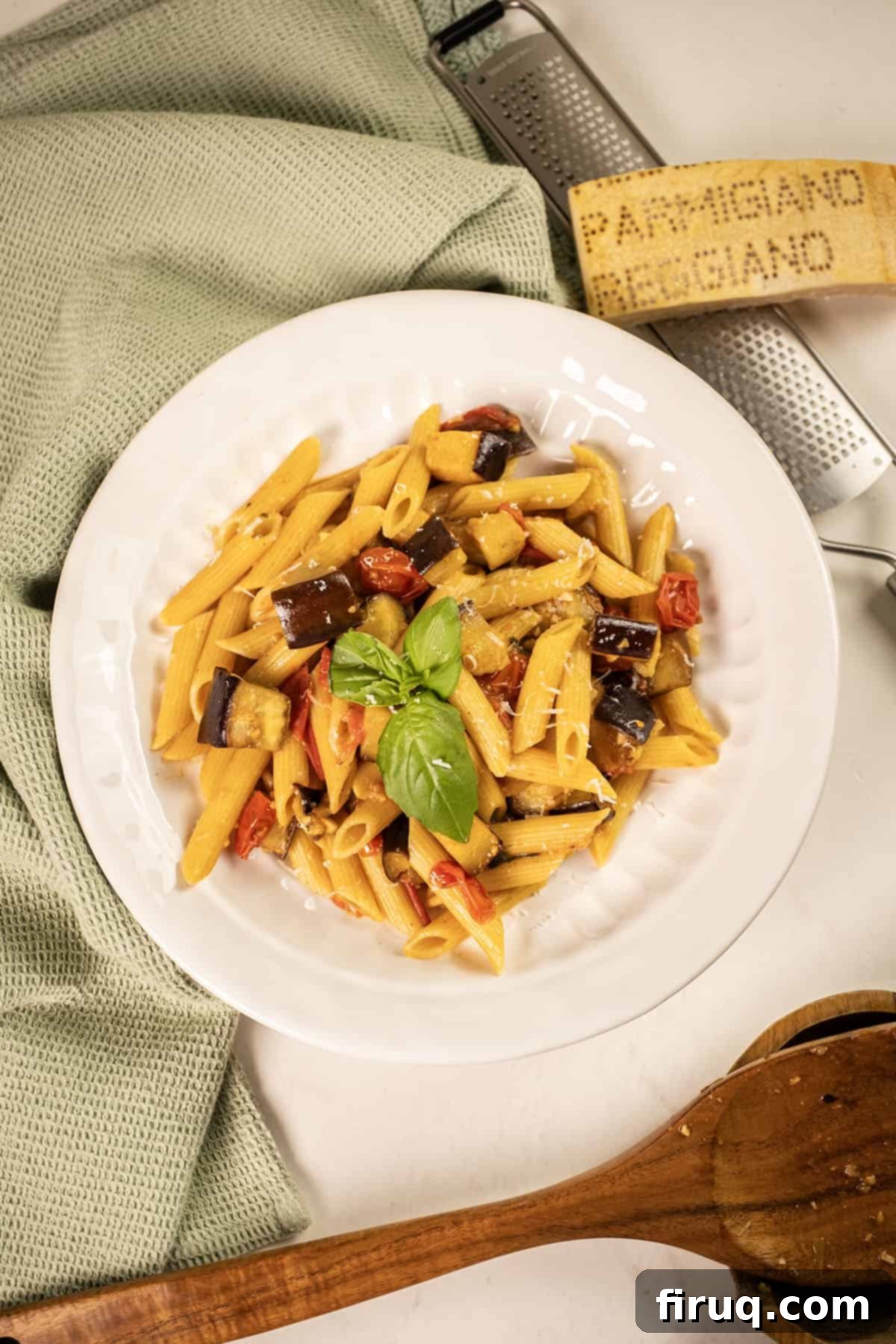
In the mood for more effortless pasta recipes? Don’t miss out on our refreshing Italian Summer Pasta with Zucchini or the incredibly speedy 15-Minute Spaghetti with Garlic and Oil. These recipes are designed to bring the authentic taste of Italy to your table without spending hours in the kitchen.
If you’re eager to jump straight to the cooking, use our convenient recipe jump-to feature below to navigate through the sections!
[feast_advanced_jump_to]
Easy “Pasta alla Norma” – A Simplified Classic
While this delightful pasta with eggplant and tomatoes might evoke the spirit of a classic, it’s important to note that it’s not a traditional Pasta alla Norma. The true Pasta alla Norma boasts a rich Sicilian heritage, originating in Catania, Sicily, as far back as the late 1800s. A traditional Norma is characterized by its deep, slow-cooked tomato sauce, perfectly fried eggplant, and a generous topping of salted ricotta cheese, often requiring a bit more time and specific ingredients to achieve its authentic profile.
Our simple rendition, however, offers a fantastic, much quicker alternative. It captures the essence of those beloved Mediterranean flavors – the sweetness of tomatoes, the tender bite of eggplant, and aromatic herbs – but gets dinner on the table in under 45 minutes. It’s designed for modern home cooks who crave authentic taste without the extensive prep. This recipe is not only more accessible in terms of ingredients and cooking time but is also a fantastic way to ensure your family enjoys a wholesome, vegetable-packed meal. Think of it as a vibrant, red-sauce equivalent to a Pasta Primavera with Broccoli and Asparagus, but with a distinctly Italian flair that highlights seasonal produce.
The inspiration for this easy eggplant pasta recipe actually came from a pleasant surprise. My wife once brought home a can of marinated eggplant and tomato, which I initially used to whip up a quick pasta sauce. The flavors were so surprisingly good and effortlessly combined that I was immediately inspired to create a fresh, homemade version that was just as easy but even more delicious. This recipe is the culmination of that inspiration, proving that incredible flavors don’t always demand complex techniques or obscure ingredients.
Ingredient Notes and Expert Substitutions for Your Eggplant Pasta
Crafting the perfect simple eggplant pasta begins with selecting the right ingredients. Here’s a detailed look at what you’ll need and how to make smart substitutions:
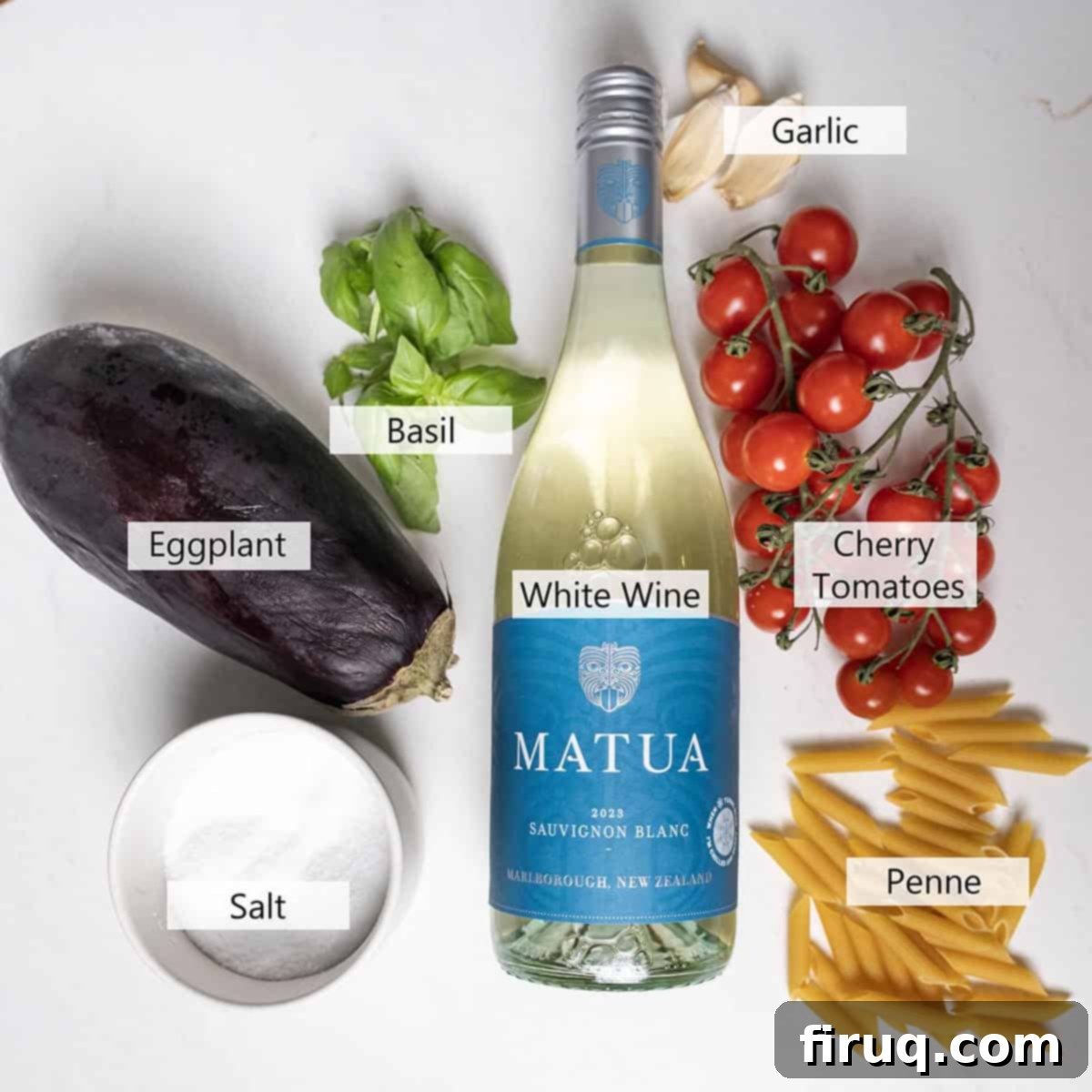
- Cherry Tomatoes: These small, sweet gems are essential for this pasta dish. I consistently choose cherry tomatoes over grape tomatoes because their skins tend to break down more effectively when cooked, creating a naturally sweet and slightly chunky sauce that adheres beautifully to the pasta. This characteristic is also why they’re my preferred choice for dishes like my Creamy Cherry Tomato Risotto.
Pro Tip: Always opt for cherry tomatoes still on the vine – they stay fresher much longer and often have a superior flavor. If fresh aren’t available, high-quality canned diced tomatoes (drained) can be a last resort, though the fresh burst of cherry tomatoes is truly unmatched. - Eggplant: For this recipe, look for a small to medium-sized eggplant that feels firm to the touch and has glossy, taut skin. A key trick is to pick one that feels relatively light for its size; this often indicates fewer seeds, which translates to a less bitter and creamier texture once cooked. Salting the eggplant before frying is a crucial step that draws out excess moisture, preventing it from becoming soggy and helping it achieve that desirable golden-brown crispness.
- White Wine: Sauvignon Blanc is my go-to for cooking this sauce, not just because it imparts a wonderful bright acidity and depth of flavor, but also because it’s a white wine I genuinely enjoy drinking. The golden rule of cooking with wine is simple: only use wine you would be happy to drink on its own. A bad wine will inevitably result in a bad dish.
Substitution: If you prefer to cook without alcohol, a good quality vegetable broth works perfectly as a substitute, maintaining the liquid consistency and adding savory notes to the sauce. - Seasoning: A harmonious balance of flavors is achieved through careful seasoning. I start by liberally salting the eggplant to draw out moisture. For the sauce, a combination of salt, freshly ground black pepper, and a pinch of crushed red pepper flakes creates a subtle warmth and a gentle kick. Don’t be shy with the seasonings, as they build the foundation of this dish’s fantastic taste.
- Garlic: Fresh garlic cloves are non-negotiable for that authentic Italian aroma and taste. Minced garlic quickly infuses the olive oil, building a fragrant base for the sauce.
- Olive Oil: As with many simple Italian dishes, the quality of your olive oil matters significantly. Use a good extra virgin olive oil for both frying the eggplant and building the sauce base – its fruity notes will shine through.
- Pasta: While the recipe specifies penne or rigatoni, which are excellent choices for catching the chunky sauce, you can certainly experiment with other short pasta shapes like farfalle, orecchiette, or even a long pasta like spaghetti or bucatini if you prefer. Just ensure it’s cooked al dente for the best texture.
*Please refer to the detailed recipe card below for precise measurements and a comprehensive list of all ingredients.
How to Make a Simple Pasta with Eggplant and Tomatoes: Step-by-Step Guide
This simple pasta recipe is incredibly straightforward, proving that you don’t need complex techniques to create a truly delicious and light Italian-inspired meal. Follow these easy steps to bring this flavorful dish to life:
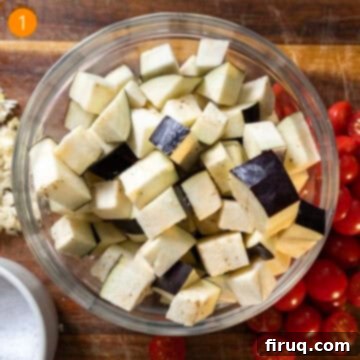
Step 1: Prepare the Eggplant. Begin by chopping your eggplant into uniform ½-inch pieces. Transfer them to a bowl and generously sprinkle with salt. Let the eggplant sit for at least 10 minutes. This crucial step draws out excess moisture and any potential bitterness, ensuring your eggplant fries up beautifully without becoming soggy. After 10 minutes, firmly pat dry the eggplant pieces with a paper towel to remove as much liquid as possible.
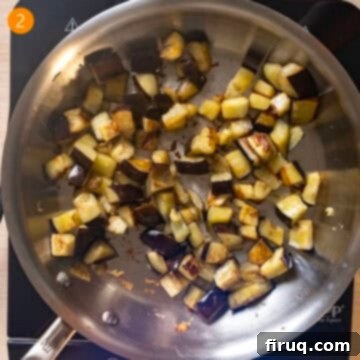
Step 2: Fry the Eggplant to Perfection. In a large saucepan, heat 3 tablespoons of olive oil over medium heat until shimmering. Carefully add your dried eggplant pieces to the hot oil. For best results, let the eggplant sit undisturbed for about 4 minutes on one side before you begin stirring. This allows a beautiful, flavorful crust to form. Continue to brown the eggplant on all sides, frying for approximately 10 minutes in total, until it’s tender with a nice charred exterior. Remove the crispy eggplant from the pan and set it aside. This charring adds a wonderful smoky depth to the dish.
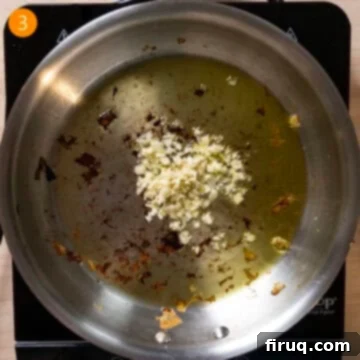
Step 3: Begin the Sauce and Pasta. In a separate large pan (or clean the eggplant pan if you prefer), heat 2 tablespoons of fresh olive oil over medium heat. Add the minced garlic and sauté for just one minute until fragrant – be careful not to burn it! In the meantime, bring a large pot of water to a rolling boil. Once boiling, generously salt the water (it should taste like the sea!) and add your pasta of choice. Cook according to package directions, ensuring it’s al dente. Crucially, before draining, make sure to save 1 cup of this starchy pasta water – it’s key to creating a silky, emulsified sauce.
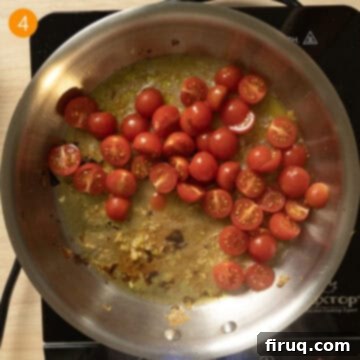
Step 4: Build the Tomato Base. To the fragrant garlic, add the black pepper and crushed red pepper flakes for a subtle kick. Then, stir in the halved cherry tomatoes and 1 teaspoon of salt. Stir everything well, ensuring the tomatoes are coated. Let the tomatoes gently simmer and break down for 3-5 minutes, releasing their sweet juices and forming the base of your luscious sauce. They will soften and begin to collapse, creating a rustic texture.
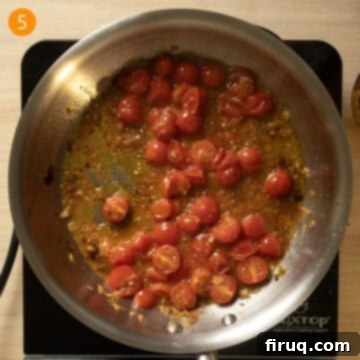
Step 5: Deglaze and Thicken with Wine. Pour in the white wine, stirring gently to deglaze the pan and incorporate any flavorful bits stuck to the bottom. Let the sauce simmer until the white wine reduces by about half. As the alcohol cooks off and the liquid evaporates, the flavors will concentrate and the sauce should visibly begin to thicken. You’ll observe little bubbles forming, indicating the sauce is reducing beautifully and gaining body.
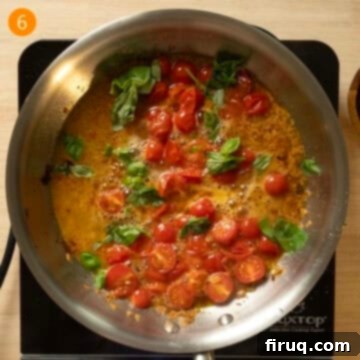
Step 6: Incorporate Basil and Pasta Water. Stir in the fresh basil leaves. The vibrant aroma of basil is best preserved when added towards the end of cooking. Next, add the reserved pasta water. The starch from the pasta water is essential for emulsifying the sauce, helping it cling perfectly to every strand of pasta. Continue to simmer the sauce gently, allowing the flavors to meld and the sauce to reach a desirable consistency. This step ensures a wonderfully cohesive dish.
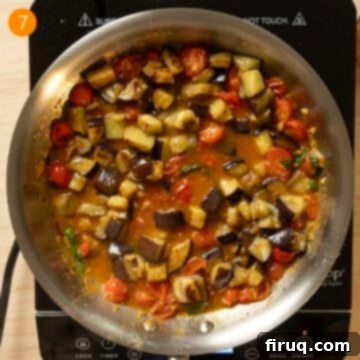
Step 7: Reintroduce Eggplant and Simmer. Now, gently stir the fried eggplant pieces back into the simmering tomato and wine sauce. Mix everything thoroughly until the eggplant is evenly distributed and coated in the rich sauce. Allow the sauce to simmer for another 5 minutes. This final simmer ensures the eggplant reabsorbs some of the sauce’s flavors and all the ingredients truly harmonize.
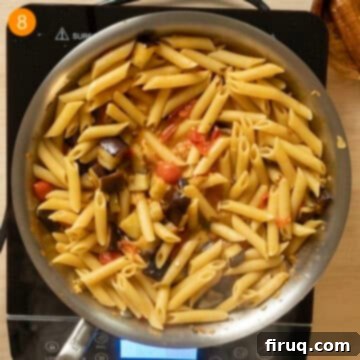
Step 8: Combine Pasta and Serve. Finally, add the cooked pasta directly into the pan with the sauce and eggplant. Toss everything together vigorously until the pasta is completely coated with the rich, flavorful sauce. If the sauce appears too thick or not enough to coat all the pasta, gradually add more of the reserved pasta water until you reach your desired consistency. Serve immediately, garnished generously with freshly grated Parmesan cheese and a sprinkle of extra fresh basil for a vibrant finish. Enjoy this delightful and satisfying simple pasta with eggplant and tomatoes!
To make this an even more robust and balanced meal, consider serving this delicious simple pasta with eggplant and tomatoes alongside some protein. It pairs wonderfully with crispy options like Italian Chicken Cutlets or the perfectly seared Cast Iron Chicken Breast! This combination ensures a wholesome, easy meal featuring a fantastic blend of fresh vegetables, satisfying protein, and, of course, everyone’s favorite: pasta!
Pro-Tips for Your Perfect Eggplant Pasta
Achieve an even more impressive simple pasta with eggplant and tomatoes by keeping these expert tips in mind:
- Let the Tomatoes Do Their Work. When adding the cherry tomatoes, resist the urge to immediately crush them. Allow them to break down naturally on their own in the simmering sauce. The heat will cause their skins to soften and burst, releasing their sweet, concentrated juices, which forms the core of your flavorful sauce. This organic breakdown provides a much richer, more nuanced tomato flavor than forced crushing. Cherry tomatoes are particularly good for this as their thin skins yield easily compared to larger grape tomatoes.
- Mastering Eggplant Frying. Eggplant is notorious for being a “thirsty” vegetable, soaking up a significant amount of oil initially. Don’t be alarmed by this; it’s part of the process. Let the eggplant pieces sit undisturbed in the pan for a few minutes on each side. As they fry and cook through, they will gradually release some of the absorbed oil and begin to brown beautifully. This undisturbed cooking is crucial for developing a delicious, charred crust and preventing them from becoming greasy. If you notice the eggplant isn’t browning evenly and is just getting “spotted” with brown dots, you might need to add a touch more olive oil to ensure proper frying and a golden-brown finish.
- The Magic of Pasta Water. Never underestimate the power of the starchy pasta water! It is absolutely essential for creating a cohesive, silky sauce that properly coats every piece of pasta. The starches released from the pasta during cooking act as a natural emulsifier, helping the oil and water in your sauce bind together. This transforms what could be a watery sauce into a luscious, glossy coating that adheres perfectly to your penne or rigatoni. Always save at least a cup; you might not use it all, but it’s better to have too much than too little.
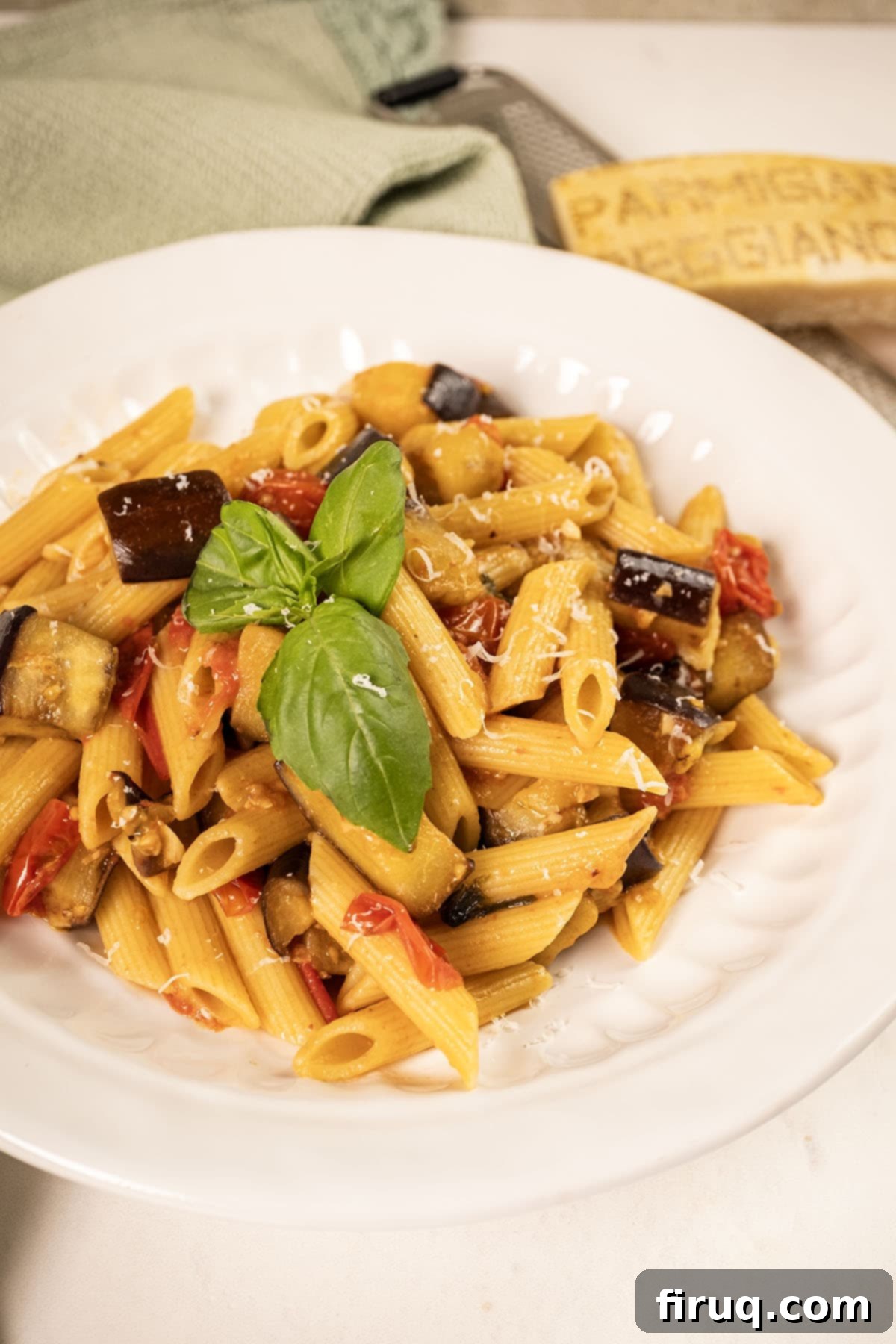
Recipe FAQs: Your Questions Answered
While this simple eggplant pasta is delicious as is, you can certainly elevate it further. Traditionally, Pasta alla Norma is served with salted ricotta cheese. Trying salted ricotta instead of or in addition to fresh Parmesan will introduce a creamy, tangy dimension that complements the fried eggplant beautifully. The eggplant itself already adds a wonderful richness and creamy texture to the pasta, making this an exquisite combination. You could also stir in a handful of fresh spinach at the very end, or a squeeze of lemon juice for brightness.
I completely agree – reheating most pasta dishes in the microwave can often lead to a dry, unappetizing result. Since this is already a lighter sauce, microwaving it could quickly dry it out. My preferred method is to gently reheat it on the stovetop. Add a splash of olive oil (and potentially a tablespoon or two of water or vegetable broth if it seems too dry) to a pan over medium-low heat. Add the leftover pasta and toss gently until it’s warmed through and the sauce is rejuvenated. Afterwards, a little fresh Parmesan and basil can bring it back to life. This technique works wonders for preserving the sauce’s texture and flavor.
While basil can contribute a subtle hint of flavor during the cooking process, its vibrant, peppery, and aromatic notes are best preserved and truly tasted when added at the very end. The high heat of prolonged cooking can diminish basil’s delicate oils and freshness. I find this simple eggplant and tomato pasta to be the perfect type of dish where adding basil towards the end makes a huge difference in the final aroma and taste, adding a burst of freshness that brightens the entire meal. It’s a technique I’ve tested with various dishes, and it consistently yields superior results, allowing the basil to shine.
Absolutely! This recipe is easily adaptable for a vegan diet. Simply omit the Parmesan cheese when serving. Ensure your white wine is vegan-friendly (some wines use animal products in fining). For an extra layer of flavor and creaminess often achieved with cheese, you could sprinkle with nutritional yeast or a vegan Parmesan alternative.
While eggplant and tomatoes are the stars, this versatile pasta welcomes other vegetables. Consider adding zucchini, bell peppers (red or yellow for sweetness), or even some tender asparagus spears alongside the eggplant. Sauté them briefly before adding the tomatoes to ensure they cook through. Just be mindful not to overcrowd the pan, as this can steam the vegetables instead of browning them.
Leftovers of this pasta dish can be stored in an airtight container in the refrigerator for up to 3-4 days. For best quality and texture, it’s generally best enjoyed fresh. Freezing is possible, but pasta dishes with delicate sauces and fried vegetables like eggplant can sometimes become a bit mushy or change texture upon thawing and reheating. If you choose to freeze, store the sauce and pasta separately if possible, and then combine and reheat slowly on the stovetop with a little extra liquid.
More Simple Pasta Recipes You’ll Love
If you’ve enjoyed the simplicity and flavor of this eggplant pasta, you’ll love exploring these other easy and delicious pasta recipes from our kitchen. Each one is designed to bring fantastic taste to your table with minimal fuss.
- Pasta with Sausage and Broccoli Rabe
- Pasta with Peas and Pancetta
- Lemon Pasta with Spinach
- Busiate with Pesto Trapanese
We truly hope you enjoy making and savoring this incredible simple pasta with eggplant and tomatoes. Please don’t hesitate to leave a comment and a star rating below in the recipe card! We absolutely love hearing your thoughts and experiences with our recipes. Also, feel free to tag us on Instagram @vindelgiudice to share your culinary creations!
📖 Recipe
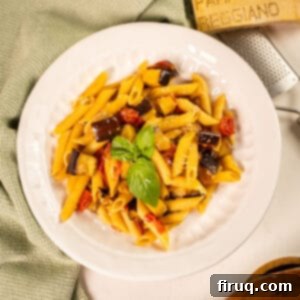
Simple Pasta with Eggplant and Tomatoes
Vincent DelGiudice
Pin Recipe
Equipment
-
1 large pot
-
1 large saucepan
Ingredients
- 3 tablespoon olive oil
- 1 eggplant, chopped into ½ inch pieces
- 2 tsp salt
- 2 tbsp olive oil
- 4 cloves garlic, minced
- ½ teaspoon crushed red pepper
- ½ teaspoon black pepper
- 1 cup cherry tomatoes, halved
- ½ cup white wine
- 1 handful basil leaves
- ½ cup pasta water
- ½ lb penne or rigatoni
Instructions
-
Chop the eggplant and place it in a bowl. Sprinkle the eggplant with salt and let it sit for 10 minutes. Pat dry with a paper towel.
-
In a large saucepan, heat 3 tablespoon of olive oil to medium heat. Once hot, place your eggplant in the pan and fry. Let the eggplant sit undisturbed for 4 minutes before stirring. Brown the eggplant on all sides, frying for about 10 minutes total. Remove the eggplant and set it aside.
-
Bring a pot of water to a boil. Salt the water well when it reaches a boil and add your pasta of choice. Make sure to save 1 cup of pasta water.
-
In a large pan, heat 2 tablespoon of olive oil to medium heat. Add the garlic and saute for one minute. Add in the black and crushed red pepper. Then stir in the halved cherry tomatoes and 1 teaspoon of salt. Stir well and let the tomatoes break down for 3-5 minutes.
-
Pour in the white wine and simmer until the white wine reduces by about half. The sauce should begin to thicken. You’ll notice little bubbles in the sauce. Stir in the basil and add the pasta water. Continue to simmer.
-
Stir in the eggplant. Mix well until everything is completely combined. Let the sauce simmer for 5 minutes. Add in the pasta and combine well. If there isn’t enough sauce, slowly add more pasta water.
-
Serve with parmesan cheese!
Notes
- Let the tomatoes break down on their own. Let the skins soften before trying to break them all open. I always use cherry tomatoes. I find they break down a lot easier than grape tomatoes.
- The eggplant will soak up a lot of the oil at first. Let them sit for a while, and they will start to let some of it back out as they fry. Add more oil if the eggplant isn’t browning and it’s just getting “spotted” with brown dots.
- You have to use the pasta water to get the sauce to coat the pasta. This light sauce really needs the extra starch to thicken up.
Nutrition
